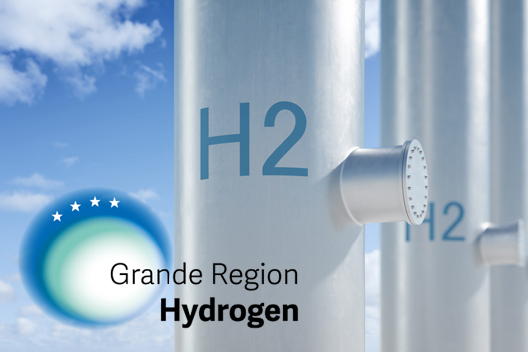Develop and optimize a Hydrogen Economy in the Greater Region

Creos Deutschland, Encevo, GazelEnergie, GRTgaz, H2V, Hydrogène de France, SHS - Stahl-Holding-Saar GmbH and Steag GmbH have constituted themselves as the European Economic Interest Grouping (EEIG) "Grande Region Hydrogen".
The Members of the EEIG have, each individually and partially together, set themselves the goal of establishing an integrated cross-border energy system in the Greater Region by linking cross-sector projects (hydrogen production, transport, and consumption). The “Grande Region Hydrogen” is composed of interconnected projects that are relying on each other. Furthermore, it will foster synergies to develop the whole value chain of the hydrogen market.
The focus area is the Federal state of Saarland (Germany), the Lorraine Region (Grand-Est - France) and the Grand Duchy of Luxembourg. The aim is to develop and optimize a hydrogen economy along the entire value chain using the outstandingly suitable structural conditions of the focus area.

Romain Deshayes (Gazelenergie), Anamaria Zianveni (Encevo), Geoffroy Anger (GRTgaz), Leo Benotteau (HDF Energy), Philip Brammen (Steag), Frank Gawantka (Creos), Katharina Poirier (H2V), Michael Marion (SHS - Stahl-Holding-Saar)
Environmental impacts
The Grande Region Hydrogen will help decarbonize the industry and parts of the mobility sector and generate emission savings, which comes in line with the objectives set by the European Commission and the Green Deal to reach carbon neutrality by 2050. The projects part of the ecosystem should reduce CO2 emissions by more than 980,000 tons/year by 2030.

mosaHYc installation - photo: GRTgaz/BN
Social impacts
Moreover, the projects part of the Grande Region Hydrogen will enable the transformation of Carling - Saint-Avold and Völklingen platforms toward hydrogen production, providing new expertise and job creation in the heart of Europe. Over 140 new direct jobs and 230 indirect jobs are expected, thus improving skills development through research and universities programs.
Economic impacts
Finally, the projects part of the Grande Region Hydrogen will participate in the economic growth of the region, with significant investments (more than 600 M€ for production facilities and transportation infrastructures). On the one hand, it will produce up to 61,000 tons of hydrogen per year. On the other hand, the open access transport infrastructure will generate economic gains through optimized demand and supply matching. This scaling up effect will contribute to reducing the renewable hydrogen final price, an important step in the European hydrogen market development.
The Grande Region Hydrogen will also contribute to the attractiveness of this cross-border region because it opens the perspective for a new industrial chapter after the coal era, relying on green energy at a competitive price.
Read more

Grande Region Hydrogen
